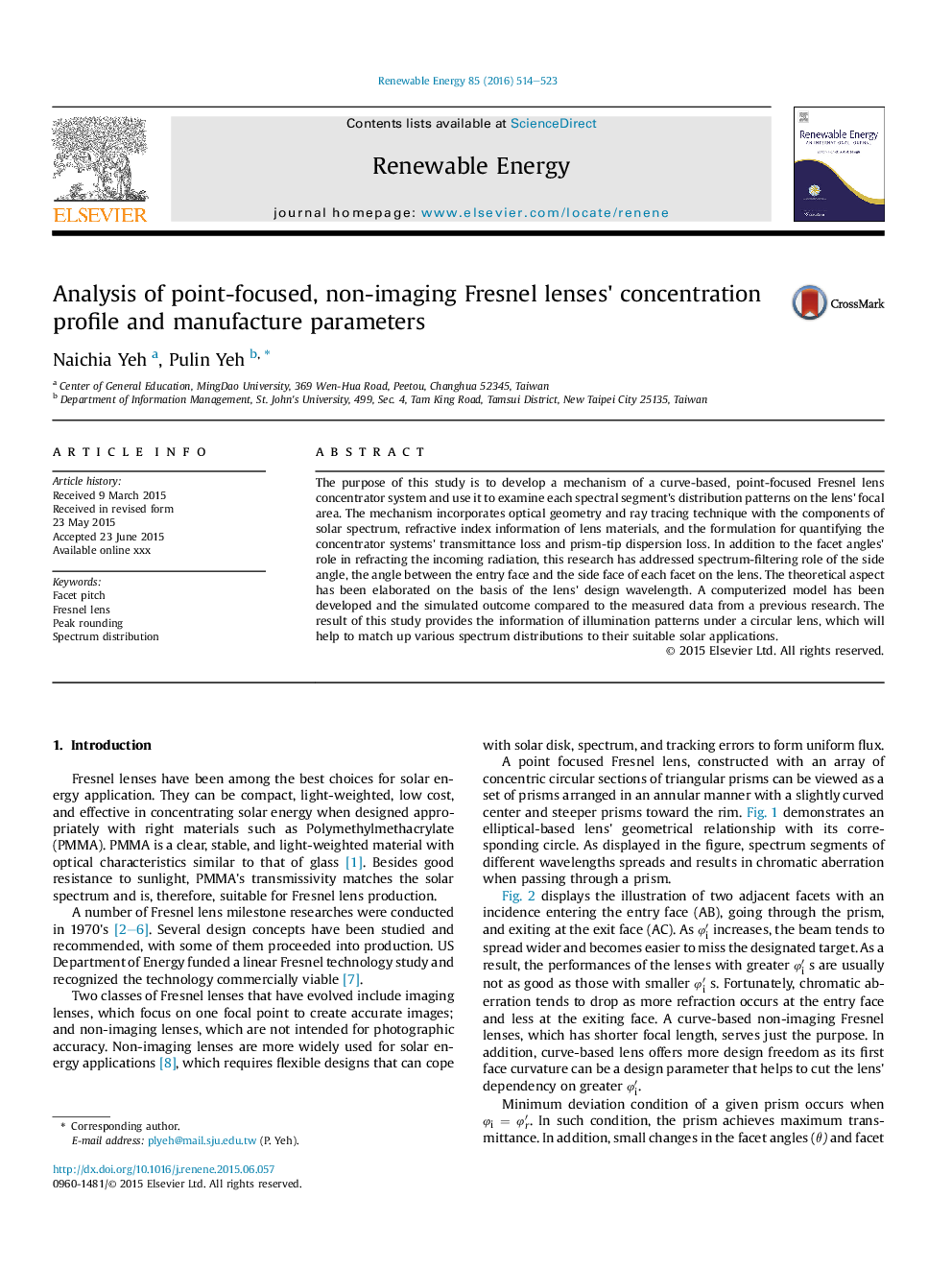| کد مقاله | کد نشریه | سال انتشار | مقاله انگلیسی | نسخه تمام متن |
|---|---|---|---|---|
| 6766647 | 512455 | 2016 | 10 صفحه PDF | دانلود رایگان |
عنوان انگلیسی مقاله ISI
Analysis of point-focused, non-imaging Fresnel lenses' concentration profile and manufacture parameters
ترجمه فارسی عنوان
تجزیه و تحلیل پروفیل غلظت لنزهای فرسل و پارامترهای تولید با تمرکز نقطه ای متمرکز شده است
دانلود مقاله + سفارش ترجمه
دانلود مقاله ISI انگلیسی
رایگان برای ایرانیان
کلمات کلیدی
ترجمه چکیده
هدف از این مطالعه ایجاد مکانیسم یک سیستم کنتراست لنز فرسل مبتنی بر منحنی و متمرکز است و از آن برای بررسی هر یک از الگوهای توزیع طیف طیفی در محدوده کانونی لنز استفاده شده است. این مکانیزم شامل روش هندسی نوری و روش ردیابی اشعه با اجزای طیف خورشیدی، اطلاعات شاخص انکسار مواد لنز و فرمول بندی برای اندازه گیری از دست دادن انتقال از طریق سیستم کنتراتور و از دست دادن پراکندگی منحنی - نوک است. این تحقیق علاوه بر نقش زاویه های چهره در ریزش تابش ورودی، نقش نقش فیلتر کردن طیفی زاویه، زاویه بین صورت و چهره هر عنصر در لنز را مورد بررسی قرار داده است. جنبه نظری بر اساس طول موج طراحی لنز مشخص شده است. یک مدل کامپیوتری توسعه داده شده و نتیجه شبیه سازی شده با داده های اندازه گیری شده از یک تحقیق قبلی مقایسه شده است. نتیجه این مطالعه اطلاعاتی از الگوهای نورپردازی تحت یک لنز دایره ای را فراهم می کند که کمک می کند تا توزیع طیف های مختلف را به برنامه های کاربردی خورشیدی مناسب آنها مطابقت بدهد.
موضوعات مرتبط
مهندسی و علوم پایه
مهندسی انرژی
انرژی های تجدید پذیر، توسعه پایدار و محیط زیست
چکیده انگلیسی
The purpose of this study is to develop a mechanism of a curve-based, point-focused Fresnel lens concentrator system and use it to examine each spectral segment's distribution patterns on the lens' focal area. The mechanism incorporates optical geometry and ray tracing technique with the components of solar spectrum, refractive index information of lens materials, and the formulation for quantifying the concentrator systems' transmittance loss and prism-tip dispersion loss. In addition to the facet angles' role in refracting the incoming radiation, this research has addressed spectrum-filtering role of the side angle, the angle between the entry face and the side face of each facet on the lens. The theoretical aspect has been elaborated on the basis of the lens' design wavelength. A computerized model has been developed and the simulated outcome compared to the measured data from a previous research. The result of this study provides the information of illumination patterns under a circular lens, which will help to match up various spectrum distributions to their suitable solar applications.
ناشر
Database: Elsevier - ScienceDirect (ساینس دایرکت)
Journal: Renewable Energy - Volume 85, January 2016, Pages 514-523
Journal: Renewable Energy - Volume 85, January 2016, Pages 514-523
نویسندگان
Naichia Yeh, Pulin Yeh,
